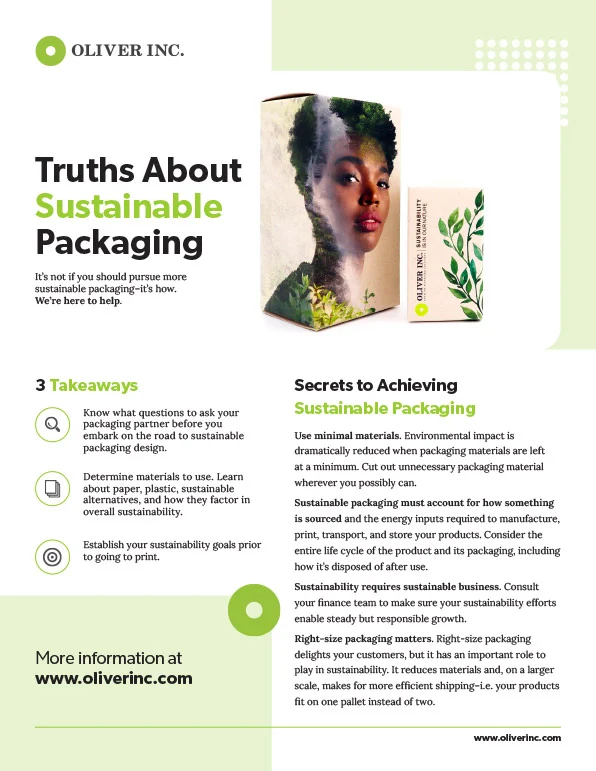Cartons vs. Plastic Containers
Posted by Oliver Inc. on 20th Oct 2022
The choice between folding cartons and plastic containers is not a straightforward one, economically or environmentally.
However, by examining the differences between how cartons and plastics are manufactured and implementing a few central sustainable packaging principles, you can more easily navigate which route toward sustainability makes the most sense for your brand.
Let’s dive into it.
How Cartons & Plastic Containers Are Manufactured
To fully appreciate the benefits and disadvantages between paperboard cartons and plastic regarding sustainability, one needs to examine how they’re manufactured, shipped, and what happens after consumer use.
Plastic Containers
Plastic is derived from petroleum and takes centuries to degrade, which is why recycling and smart employment of plastic packaging is paramount. Although we’re experiencing a rise in alternative energy and more sustainable lifestyle choices, it appears our reliance on plastics will continue to prove difficult to overcome.
On a technical level, most packaging plastics consist of polyethylene, a synthetic polymer with some kinship to nylon, teflon, polyester, and epoxy. You’ll encounter other types of plastics in packaging, such as polystyrene, polypropylene, polyethylene terephthalate, and polyvinyl chloride.
Plastic has abundant uses due to its lightweight, durable, and adaptable nature. It can be shaped to fit nearly any mold and thickened to protect or secure an almost limitless number of products.
Plastic is also popular because it scales so well in mass industrial processes. In other words, it can be expensive to fabricate in small quantities, but when peddling in massive quantities, it becomes incredibly economical.
Folding Cartons
Alternatively, cardboard and paperboard come from trees. Although trees are an especially renewable resource (just need sun, water, and naturally occurring nutrients), they take time to grow. Plus, there are many ways to irresponsibly harvest lumber or mismanage forests, damaging vital ecosystems.
Paper is the result of a pulping process in which trees are sawed down, shredded into wood chips, and then boiled in water (and sometimes other chemicals). This pulp is then spread thin across flat surfaces and dried into its final form.
Notably, while paper may be more renewable than petroleum, producing plastic is vastly more energy efficient than manufacturing paper. For example, according to a now highly cited 2011 report from the Northern Ireland Assembly, it takes four times as much energy to produce a paper bag than it does plastic. Furthermore, paper bags “generate 70% more air and 50 times more water pollutants than plastic bags.”
And although the report estimates that it takes between 400 and 1,000 years for plastics to degrade, we shouldn’t overlook the reality that plastics have a dramatically lower carbon footprint than paper products—at least during the manufacturing phase.
Things become more complicated the further we go through the life cycle of folding cartons and plastic containers, however.
Because plastic doesn’t often end up recycled (compared to paper’s high recycling rates), it becomes incinerated or burnt into toxic gasses. So while plastics may be less energy intensive to manufacture, they might also have a carbon footprint several times larger than paper once they’ve gone through their entire life cycle.
On the other hand, due to its incredible light weight, plastics can have a lower carbon footprint with regards to shipping and transportation. Paperboard and cardboard have to weigh a lot more to provide the same rigidity and support plastics can often offer.
Ultimately, since paper has a lower carbon footprint (across its life cycle), relies more heavily on recycled contents, and ends up being recycled more frequently than plastic, it’s usually (but not always) the more environmentally friendly packaging option.
(Don’t overlook other sustainable paperboard alternatives, either.)
So What Makes Packaging Sustainable?
This complicated covey of factors makes it difficult to know whether cartons or plastic containers are more environmentally conscious. By abiding by a few more sustainable packaging principles, you should find a clear path forward that fits your particular situation.
Sustainable packaging means leaving the smallest environmental impact possible, from the manufacturing and shipping process to storage and post-consumer use of your products and packaging materials. To achieve this, sustainable brands minimize their carbon footprint, source paperboard and cardboard from responsibly managed forests, localize supply chains, and practice right-size packaging principles.
Minimizing Your Carbon Footprint
To reduce your carbon footprint, you must pay attention to every activity throughout your entire production, shipping, and packaging process.
What energy sources do your machines or warehouses use? What about those utilized by your printing and packaging partners? Where else can you reduce carbon waste in your processes?
Source from Responsibly Managed Forests
To ensure your paper-based packaging materials are sustainably sourced, collaborate with a partner certified by the nonprofit Forest Stewardship Council (FSC), Sustainable Forest Initiative (SFI), or Programme for the Endorsement of Forest Certification (PEFC).
Localizing Your Supply Chains
By shortening your supply chain, shipping regionally and partnering primarily with local producers and manufacturers, you reduce carbon emissions endemic to long shipping lines and needless transportation. Plus, you gain the ability to more closely monitor third-party processes and ensure partners abide by ethical practices.
Right-Size Packaging
In the realm of printing and packaging, right-size packaging is economical and sustainable.
Put simply, it means utilizing only as much packaging material as you need to protect and secure your products. This entails removing unnecessary air pockets and superfluous packaging layers that frustrate and alienate more environmentally conscious consumers.
Determining whether paper cartons or plastic containers are the more environmentally friendly option depends on many factors. But by taking these into account, and doing a bit further research regarding your particular situation, you should have confidence the path you're taking is a green one.
If you’re still unsure, an experienced printing and packaging partner should be able to help you identify which options are the most ecologically sound for your brand.






